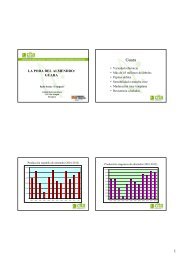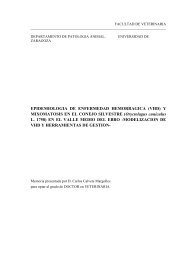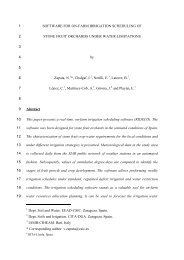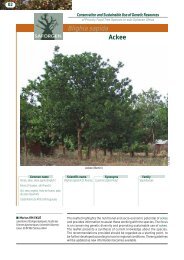1 A Recursive Dynamic Computable General Equilibrium Model For ...
1 A Recursive Dynamic Computable General Equilibrium Model For ...
1 A Recursive Dynamic Computable General Equilibrium Model For ...
You also want an ePaper? Increase the reach of your titles
YUMPU automatically turns print PDFs into web optimized ePapers that Google loves.
(TRANSFER(“spend”)), less social security payments and rents on publically owned<br />
buildings (TRANSFER(“rev”)) and direct income taxes on salaries, estates etc<br />
(V0HHTAX). Summing over these concepts gives the value €712,671 million. In the<br />
standard ORANI-G model, the percentage change in aggregate household expenditure<br />
(w3tot_h) is linked to changes in the value of Spanish GDP (w0gdpinc). In our modified<br />
model, percentage changes in aggregate household expenditure and direct income taxes<br />
(w0hhtax) are now proportionally linked to aggregate household disposable income<br />
(w0hhinc) via the linear equations:<br />
w3tot<br />
_ h = f 3tot<br />
+ w0hhinc<br />
w0hhtax<br />
= w0hhinc<br />
+ finctax<br />
where w0hhtax is used to update V0HHTAX, w0hhinc is employed to update V0HHINC<br />
and f3tot and finctax are exogenous shifter variables. The latter can be employed to<br />
manipulate (uniform) direct taxes rates, which also has feedback effects on the government<br />
budget.<br />
9. Closure and shocks in dynamic ORANI-DYN<br />
As is typical in the CGE model approach, the number of variables (n) will exceed the<br />
number of equations (m), which requires (n-m) exogenous variables. From a mathematical<br />
perspective, the exogenous-endogenous split must ensure that the endogenous coefficient<br />
matrix is invertible. It is, however, the realm of economics to which we must turn in order<br />
to guide our choice of appropriate closure. This may be guided by specific considerations:<br />
Firstly, how available are the data? Economics has relatively little to say about non<br />
price determinants (i.e., taste, productivity). Consequently, such variables are typically<br />
maintained as exogenous over time. If ‘acceptable’ proxy data are available, then exogenous<br />
shocks may be applied within a baseline scenario (see later discussion).<br />
Secondly, what is the maintained hypothesis for the macro economy. It may be that<br />
the modeller wishes to focus on the short run impacts. In this case, a closure where real<br />
wages are fixed (controlled by unions) under the ‘sticky wages’ hypothesis is more<br />
appropriate. With a closure change, a long run labour market scenario could imply fully<br />
flexible real wages (i.e., labour supply fixed and real wages fully flexible).<br />
Thirdly, there is the issue of what the focus of the simulation is. <strong>For</strong> example, it may<br />
be that the impact of milk quotas is of paramount importance – thus, the milk quota must<br />
be exogenised, whilst rent should be allowed to adjust endogenously. Alternatively, if an<br />
import quantity is exogenised, the corresponding price imported will need to be<br />
endogenous (to capture, say an import quota). Likewise, with a price fixing closure<br />
(exogenous price), the quantity should be allowed to adjust. If both price and quantity are<br />
exogenised in a given market, we must allow the non own-price determinants to change<br />
43<br />
(33)
















